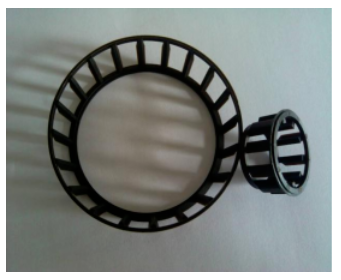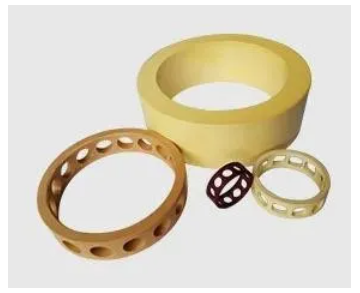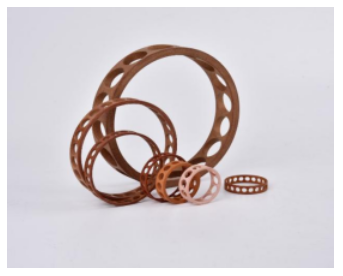
Last time we discussed the selection of cage materials for high-precision bearings, high-precision bearings are a class of special bearings to meet the needs of precision machine tools and other precision equipment, including high-precision angular contact ball bearings, cylindrical roller bearings, one-way and two-way thrust angular contact ball bearings, deep groove ball bearings, etc. It has the characteristics of high speed, high precision, high stiffness, low temperature rise, low vibration and low noise. In order to ensure the above characteristics of high-precision bearings, there are special requirements for the performance of cage materials, such as vibration absorption, heat resistance and wear resistance.
Cage material selection is determined based on speed, noise, vibration, lubrication and working environment. High precision bearings commonly used cage materials are polyamide, polytetrafluoroethylene, polyimide, polyphenylene sulfide, polyether ether ketone, phenolic laminate, bronze and brass, by understanding their characteristics (including the use of restrictions and limit temperature) can be selected for different types and conditions of the bearing cage material. In this issue, we briefly introduce the non-metallic materials used in high-precision bearing retainers.
Polyamide (PA)
Polyamide, commonly known as nylon, has the advantages of high mechanical strength, high softening point, heat resistance, wear resistance, low friction coefficient, self-lubrication, vibration absorption, noise attenuation, oil resistance, weak acid resistance, alkali resistance and general solvents, good insulation, self-extinguishing, non-toxic, odorless, good weather resistance, poor dyeing and so on. The disadvantage is that the water absorption is large, affecting the dimensional stability and electrical performance. Fiber reinforcement can reduce the water absorption of the resin, so that it can work at high temperatures and high humidity. Nylon and glass fiber affinity is very good.

Polytetrafluoroethylene (PTEE)
Compared with ordinary plastics, PTFE has the following excellent characteristics:
(1) High and low temperature resistance. PTFE is not affected by temperature, the temperature range is wide, it is still ductile at -260 ° C, and it maintains excellent mechanical properties when heated for a long time below 250 ° C.
(2) Chemical corrosion resistance and weather resistance. In addition to molten alkali metals, fluorinated media and sodium hydroxide above 300 ° C, PTFE is almost immune to any chemical corrosion. For example, in concentrated sulfuric acid, nitric acid, hydrochloric acid, and even in aqua aqua boiling, its quality and performance are unchanged, and it is almost insoluble in any solvent, only slightly soluble in total alkane above 300 ° C (about 0.1g / 100 g). PTFE does not absorb moisture, is not easy to burn, and is extremely stable to oxygen and ultraviolet light, so it has excellent weather resistance.
(3) Insulation. PTFE has low dielectric constant and dielectric loss over a wide frequency range, and high breakdown voltage, volume resistivity and arc resistance.
(4) Self-lubricity. PTFE has the lowest coefficient of friction of all plastics, making it an ideal oil-free lubricating material.
(5) Non-stickiness. PTFE is a solid material with the smallest surface energy, and no known solid matter can adhere to its surface.
Polyimide (PI)
PI has been widely concerned and applied because of its unique comprehensive properties such as high temperature resistance, oxidation resistance, radiation resistance, corrosion resistance, moisture and heat resistance, high strength and high modulus. The chemical structure of PI determines that it has many excellent properties, mainly including:

(1) Heat resistance. The decomposition temperature of PI generally exceeds 500℃. Sometimes even higher, is currently known to be one of the most thermally stable varieties of organic polymers, mainly because of the molecular chain contains a large number of aromatic rings.
(2) Mechanical properties. The tensile strength of unreinforced matrix materials is above 100 MPa. The tensile strength of Kapton films prepared with homogeneous anhydride is 170 MPa, while biphenyl PI(Upilex S) can reach 400 MPa. The elastic modulus of PI fiber can reach 500 MPa. Second only to carbon fiber.
(3) Chemical stability and resistance to moisture and heat. PI materials are generally insoluble in organic solvents and resistant to corrosion and hydrolysis. Variations in molecular design can result in varieties with different structures. These properties are stable over a wide range of temperatures and frequencies. In addition, PI also has the characteristics of low temperature resistance, low expansion coefficient, flame retardant and good biocompatibility. PI's excellent comprehensive properties and diversity in synthetic chemistry make it widely used in a variety of fields.
Phenolic laminated cloth pipe
The phenolic laminated cloth pipe has the advantages of low density, high mechanical strength, good machining performance, heat resistance, oil absorption and oil penetration. Phenolic laminate tube cage has high mechanical strength, wear resistance and self-lubrication performance, and has certain elasticity, plasticity, stiffness, hardness, impact toughness, fatigue strength and fracture toughness, etc. Good vibration absorption is suitable for high-speed oil lubrication, and water contact expansion affects its performance. The temperature range of phenolic laminate tube plastic cage bearings is -40 ~ 120℃.

Conclusion
In the course of introducing bearing cage materials, we have explored the characteristics of various materials and their advantages in specific applications. Choosing the right cage material is crucial to ensuring the performance of the bearing and extending its service life. Different operating conditions, such as temperature, speed, load, and environmental factors, affect material selection decisions. Different decisions will also affect the use of bearing cages, so choosing the correct cage material is one of the necessary prerequisites to ensure bearing performance.